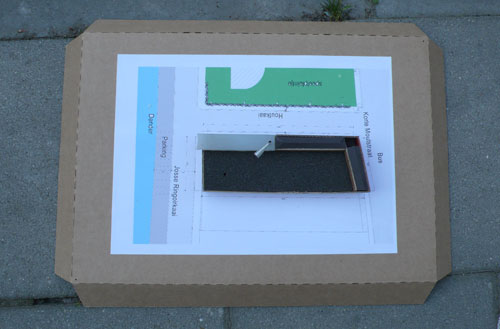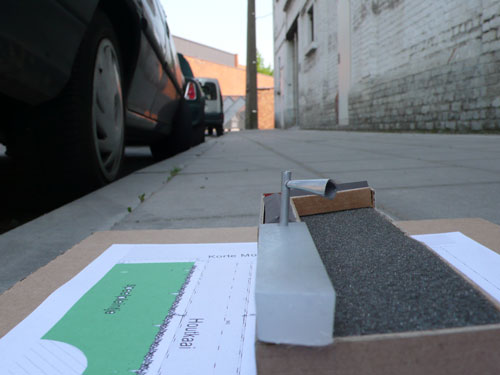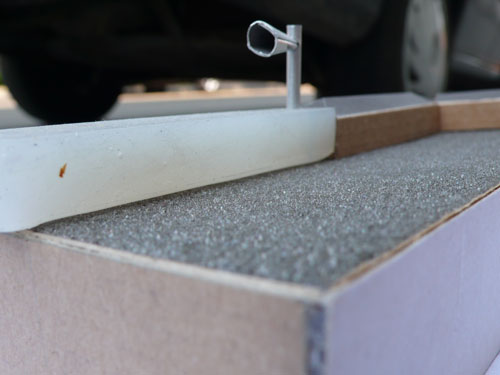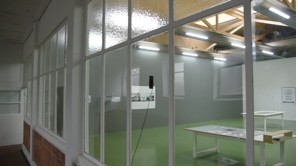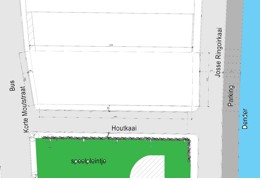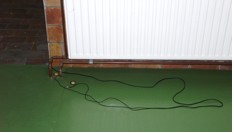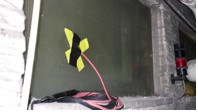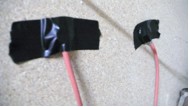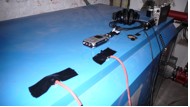|
Periskop
integration project for Netwerk Permanent Installation 2007 Concept: Aernoudt Jacobs |
|
Commissioned by Netwerk /center for contemporary art www.netwerk-art.be |
|||||||||||||
|
|
|||||||||||||
|
Architecture is based on spaces of solid constructions, whereas sound can delimit aural spaces. Sound always has a spatial quality. It is a translucent freeform of acoustic zones which can shape itself into an architectural space. Netwerk is situated next to different traffic axes; railway, canal, street (buses, cars), airway, bicycle route. The resulting sound of all these elements have – for me – always been of a peculiar presence. On sundays, the trains on the railway are most present. Typically the sound of the train when it passes over the canal on the iron bridge produces a very loud, vibrant and resonating sound. On rare occasions, when the wind blows in from the train station, train announcements can be heard very faintly. Another particularity, which is more related to the architecture, is the ambiguous inside/outside relationship on the ground floor. Pedestrains walking and talking on the sidewalk alongside the façade, sonically always seem to be inside. The auditory boundaries are very blurred. Inside Netwerk, during the grey seasons, the most present sound is the humming of the heating system. You can hear it everywhere. It has a stationary presence. When it rains, the rain-pipes are omni-present. You almost feel it raining inside. At specific moments, the building of Netwerk generates sounds related to its activities: the building of an exhibition, artworks, rehearsal, applause, the office activities, the slamming of a door. I see the building of Netwerk, due to its specific purpose, as an instrument that produces sound. The building as an object absorbs and conducts sounds from the inside as well as from its surroundings. While listening to structure borne vibrations, the building becomes a sonic filter. This perception adds a different perspective; an alienated time-space. Sounds acquire a memory, a physicality, an additional soul. For example an airplane flying over Netwerk will produce air-borne sounds, but it will also produce vibrations that can be felt and heard in solid structures or even liquids (i.e. the Dender Canal). More evidently the sound of footsteps will travel through both solids and air. I always wondered if creativity, in terms of a sonic energy flow, can be amplified with an acoustic resonator. If productivity can be transformed in a constant soundflux, could the resulting wave energy be translated into a sonic and visual concept? Could we tunnel this sound energy into a tuned space and let it vibrate, twinkle, resonate? Can the vibration be naturally amplified with resonance? Can we quantize it and make it sonically visible?
Basic principle of the installation: First Step: Gathering sounds/Microphone system Examples of collected sonic activity: Latent sounds * machinery (boilers, computers, fridge), Sounds in constricted spaces Sounds through matter Sounds in solids (contact sounds), Walls, ceilings, floor, windowpanes * Sounds in liquids (canal) Active sounds * working activity (offices, studios, gallery) * footsteps, slamming doors Environmental sounds (outside) * axes of transportation The microphone system will vary in regard to the gathered sonic activity. Some examples: * a tubed microphone in the heating room, The heating room has an unused excess space in wich we are building a long tube with a microphone. * a hydrophone in the Dender Canal, Waterproof microphone * contact microphones in the floors, doors, machinery, Piezo transducers à stethoscope microphones or accelerometers on windowpanes Second Step: Mixing desk/Amplification The mixing desk mixes the collected sonic activity (real-time!). Here all the sounds are carefully scaled in relation to each other. The sounds are also routed to different channels. From the mixing desk sounds are amplified into the resonator. Third Step: The resonator The collection of sounds is introduced in the resonator. The resonator is like a sound box in which Netwerk’s sonic productivity will be diffused/reflected/reinforced, together with its surroundings. The sound box is a tuned ‘chamber’ which strengthens the resonance of the introduced sounds by amplifying its vibrations. Like a resonance ‘chamber’ which uses resonance to amplify sound. The chamber has interior surfaces which reflect acoustic waves. When a sound enters the ‘chamber’, it bounces back and forth within the chamber with low loss. As more wave energy enters the chamber, it combines with and reinforces the standing wave, increasing its intensity (volume). The design of this chamber will be based on a classic Helmholtz resonator. Fourth Step: Periskop The resonator has some tiny doors that can be opened. Opening the doors lets you hear the soundflux. The tube has a conic opening on top in which the environmental sounds surrounding the building are entering
Origin of sounds according to the channels on the mixing desk: You can manipulate the mixing desk to isolate sounds
All the sounds will be in realtime for the actual installation Missing sounds:
future pedestrain bridge, sint annabrug
|
